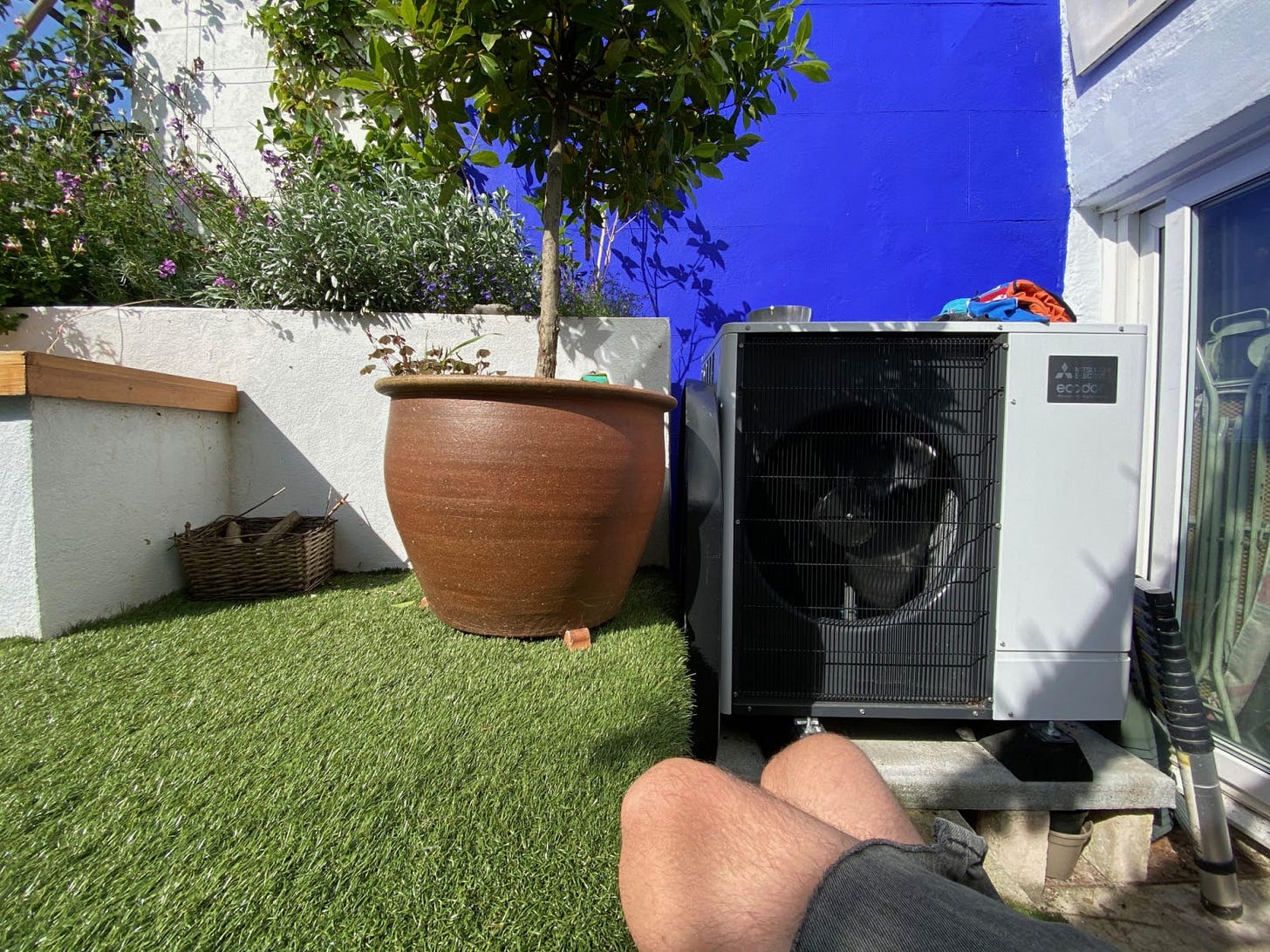Planning a net-zero home? You’ll need a heat pump
Heating accounts for most of our carbon footprint
Simple climate action // I S S U E # 3 1 // H E A T I N G
Farewell to natural gas
By Jemima Kiss
Nearly two years ago, my brother’s gas boiler started to die. With two small children and a steady supply of dirty clothes and dishes, the thought of going without hot water and heating in their old Victorian home in Brighton, UK was chilling. But the plumbers he called weren’t very reassuring. Repairs might not extend the boiler’s life much longer, and a new one would not last more than ten years. With the UK proposing ambitious climate targets, this seemed problematic.
Heating is the single largest source of UK carbon emissions, and campaigners have variously advised banning gas boilers, installing a million heat pumps by 2030, and providing more support and subsidy for upgrading insulation and better boilers in existing homes. So Tom decided to make a characteristically stubborn commitment to make the best climate choice for his home: installing a new heat pump in his 140-year old home.
Heat pumps can be powered by heat from the air, water, or the ground. Tom worked out that an air-source heat pump would work well for the home he’d just spent three years renovating and insulating, and he could fit one into their small backyard. He got quotes for installation and supply of three models that ranged from £8,500 to £13,000 ($11,800 to $18,000); none of those compared well to a new gas boiler at £2,700 ($3,700). But with a government subsidy called the Renewable Heat Incentive, Tom would receive £6,300 ($8,700) over seven years — actually making the cheapest heat pump less expensive than a new gas boiler.

One year later and — spoiler alert — Tom has been delighted with his clean, electric heat pump. He acknowledges that he’s in a lucky position to be able to afford the experiment, as well as the tenacity to dive deeply into the research. But he also says it has been the best decision for their family in every way. It has saved them money in the longer term, and given them the deep satisfaction of knowing that they - and everyone who lives in that house after them — are part of the solution.
You can read about Tom’s meticulously documented process installing the heat pump, and his update one year on. This month, we’ll be talking bout zero-carbon homes, and what it takes to get there. We’re starting with a profile of Kathy Hannun of Dandelion Thermal, a former Google X employee who wants to change how the world heats (and cools) its homes.
Geothermal: the heating solution under our feet
Some 20% of US emissions come from powering our homes.
By Willem Marx
Kathy Hannun used to sit inside Google X, the company’s experimental “moonshot factory,” surrounded by experts in robotics, artificial intelligence, and flying vehicles. Her job was to decide how to turn life-changing ideas into businesses. But her future, she decided, was not shooting for the moon. Instead she became obsessed with drilling down, sometimes hundreds of meters into the ground, to where temperatures stay a constant 55F all year round.
Hannun’s journey toward the center of the Earth began at her desk in Mountain View, California, in late 2014. A Google software developer named Bob Wyman emailed one of the company’s internal list-servs, a group of energy obsessives that would debate advancements in nuclear technology or the latest implication of solar-panel efficiency. That day, he’d written thousands of words along with detailed technical specifications and citations to make an unequivocal argument: America’s best investment against climate change is scaling up the production and installation of devices called geothermal heat pumps. “My job was to find game-changing opportunities in energy,” Hannun recalls. “[Wyman’s] statements were so sweeping and bold. It got my attention.”
At that time, citizens, businesses, and governments were beginning to grapple with the challenge of reducing carbon emissions from buildings, but the focus was on securing clean electricity. Very little attention was focused on reducing the demand for electricity all those homes and businesses required — and Wyman wanted to flip the equation on its head.
Hannun wrote back. By this time, Wyman had successfully persuaded Google to campaign for New York City to stop burning dirty fuel to heat Manhattan’s older buildings. But Wyman wanted to go bigger by providing a viable alternative that would not only address the problem in New York, but radically reconfigure the American heating market. From their joint efforts was born Dandelion Energy, a Google X initiative.
Geothermal, or ground-sourced, heat pumps warm and cool homes using the consistent temperature of the earth just 30 feet beneath our feet. That’s in contrast to air-sourced heat pumps, which rely on the temperature of the air outside a home. In the summer, ground-sourced heat pumps use a system of pipes containing a conductive fluid that extracts warmth from a home, carrying it underground, and replaces it with cooler air drawn from underground. When outdoors temperatures drop in winter, the pump becomes a heat source by carrying warmth up from beneath the ground. Coupled with effective insulation, a heat pump can entirely eliminate the need for a gas-burning boiler or conventional air conditioning system. That drastically reduces a property’s carbon emissions and —equally crucially— operating costs.
Some 200,000 ground-sourced heat pumps were installed in the US in 2019, a doubling of installations from a decade earlier. But only a fraction of American homes have taken advantage of this proven, decades-old technology. The vast majority were installed in new-build homes, with far fewer (around a quarter of US systems) introduced during retrofits of older properties.
Historically, the barrier is high upfront costs for ground-sourced or geothermal heat pumps. Despite cutting energy use in half in some older homes, the payback period for retrofits may stretch longer than five years (Dandelion’s systems cost from $18,000 to $25,000 after incentives). In new builds, however, the return on investment is often far faster. In its most optimistic forecasts, the US Department of Energy predicts almost a quarter of American homes will be using heat pumps in the coming years, with almost three million new heat-pump installations (3% of total households) annually across the United States by 2026.
Saving $1,800 per year
The geothermal heat-pump industry may now be where the solar industry was less than two decades ago. Costs are set to plummet as the industry scales up and technology standardizes. In 2000, few homeowners were installing solar panels. Today, virtually every new home in California has them on the roof (the state mandates it), and every year, solar gets cheaper (prices have dropped 89% in 10 years).
Hannun sees the industry growing quickly as economics improve, aided by early incentives. Heat pumps already enjoy a federal tax break equal to nearly 25% of the cost, and in states like New York homeowners may receive an additional $13,000. That’s still far less than the price of the heat pump, local permits, and drilling and installation costs, but Dandelion estimates that improved energy efficiency from its ground-sourced heat-pump systems can save a 2,500 square feet home in New York state around 47% on its overall heating and cooling costs — equal to more than $1,800 a year.
Now the industry needs to overcome barriers such as regulatory inconsistencies between states, training personnel, and streamlining the installation process. Government support and low-cost financing models could reduce those significantly, unlocking long-term financial benefits for homeowners, without relying on existing subsidies. “There are still so many more carrots governments could hold up,” she laughs. “It's not yet time for sticks.”
Hothouse is a weekly climate action newsletter written and edited by Jemima Kiss, Mike Coren, and Jim Giles. Everything we publish is free to read — your donations fund our writers and artists.










